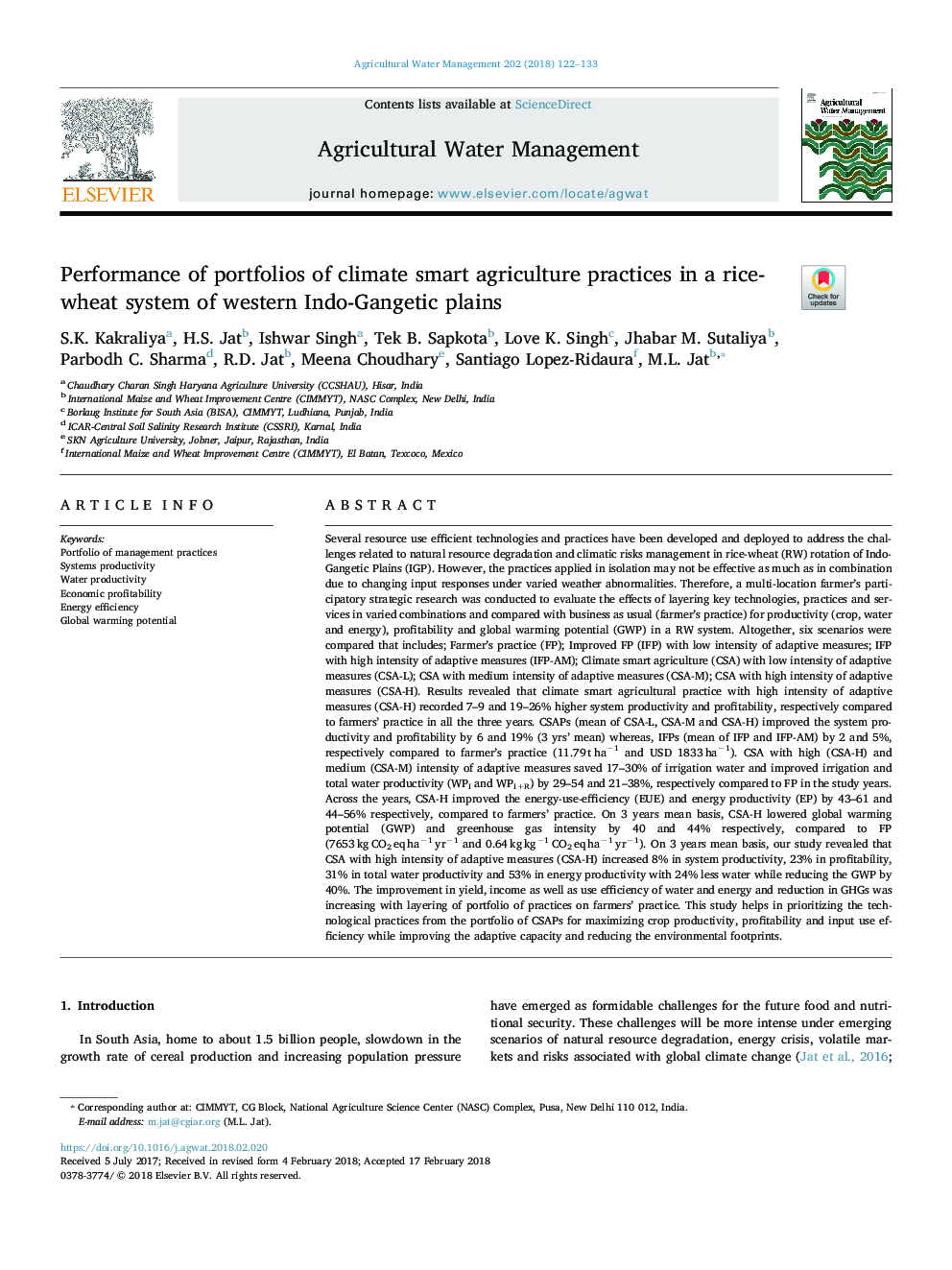| کد مقاله | کد نشریه | سال انتشار | مقاله انگلیسی | نسخه تمام متن |
|---|---|---|---|---|
| 8873022 | 1622878 | 2018 | 12 صفحه PDF | دانلود رایگان |
عنوان انگلیسی مقاله ISI
Performance of portfolios of climate smart agriculture practices in a rice-wheat system of western Indo-Gangetic plains
ترجمه فارسی عنوان
عملکرد اوراق بهادار کشاورزی عملیات هوشمند در یک سیستم گندم برنج گندم دشت غربی هند غژیک
دانلود مقاله + سفارش ترجمه
دانلود مقاله ISI انگلیسی
رایگان برای ایرانیان
کلمات کلیدی
نمونه کارها از شیوه های مدیریت، بهره وری سیستم، بهره وری آب، سودآوری اقتصادی، بهره وری انرژی، پتانسیل گرم شدن کره زمین،
موضوعات مرتبط
علوم زیستی و بیوفناوری
علوم کشاورزی و بیولوژیک
علوم زراعت و اصلاح نباتات
چکیده انگلیسی
Several resource use efficient technologies and practices have been developed and deployed to address the challenges related to natural resource degradation and climatic risks management in rice-wheat (RW) rotation of Indo-Gangetic Plains (IGP). However, the practices applied in isolation may not be effective as much as in combination due to changing input responses under varied weather abnormalities. Therefore, a multi-location farmer's participatory strategic research was conducted to evaluate the effects of layering key technologies, practices and services in varied combinations and compared with business as usual (farmer's practice) for productivity (crop, water and energy), profitability and global warming potential (GWP) in a RW system. Altogether, six scenarios were compared that includes; Farmer's practice (FP); Improved FP (IFP) with low intensity of adaptive measures; IFP with high intensity of adaptive measures (IFP-AM); Climate smart agriculture (CSA) with low intensity of adaptive measures (CSA-L); CSA with medium intensity of adaptive measures (CSA-M); CSA with high intensity of adaptive measures (CSA-H). Results revealed that climate smart agricultural practice with high intensity of adaptive measures (CSA-H) recorded 7-9 and 19-26% higher system productivity and profitability, respectively compared to farmers' practice in all the three years. CSAPs (mean of CSA-L, CSA-M and CSA-H) improved the system productivity and profitability by 6 and 19% (3 yrs' mean) whereas, IFPs (mean of IFP and IFP-AM) by 2 and 5%, respectively compared to farmer's practice (11.79â¯tâ¯haâ1 and USD 1833â¯haâ1). CSA with high (CSA-H) and medium (CSA-M) intensity of adaptive measures saved 17-30% of irrigation water and improved irrigation and total water productivity (WPI and WPI+R) by 29-54 and 21-38%, respectively compared to FP in the study years. Across the years, CSA-H improved the energy-use-efficiency (EUE) and energy productivity (EP) by 43-61 and 44-56% respectively, compared to farmers' practice. On 3 years mean basis, CSA-H lowered global warming potential (GWP) and greenhouse gas intensity by 40 and 44% respectively, compared to FP (7653â¯kgâ¯CO2â¯eqâ¯haâ1â¯yrâ1 and 0.64â¯kgâ¯kgâ1â¯CO2â¯eqâ¯haâ1â¯yrâ1). On 3 years mean basis, our study revealed that CSA with high intensity of adaptive measures (CSA-H) increased 8% in system productivity, 23% in profitability, 31% in total water productivity and 53% in energy productivity with 24% less water while reducing the GWP by 40%. The improvement in yield, income as well as use efficiency of water and energy and reduction in GHGs was increasing with layering of portfolio of practices on farmers' practice. This study helps in prioritizing the technological practices from the portfolio of CSAPs for maximizing crop productivity, profitability and input use efficiency while improving the adaptive capacity and reducing the environmental footprints.
ناشر
Database: Elsevier - ScienceDirect (ساینس دایرکت)
Journal: Agricultural Water Management - Volume 202, 1 April 2018, Pages 122-133
Journal: Agricultural Water Management - Volume 202, 1 April 2018, Pages 122-133
نویسندگان
S.K. Kakraliya, H.S. Jat, Ishwar Singh, Tek B. Sapkota, Love K. Singh, Jhabar M. Sutaliya, Parbodh C. Sharma, R.D. Jat, Meena Choudhary, Santiago Lopez-Ridaura, M.L. Jat,
